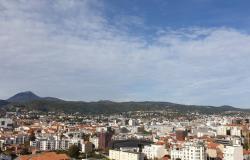“It’s not the time to take out your cell phone and text your girlfriend, it’s going to go quickly!”, warns Jean-François Mercure, the relentless sixth-grade teacher, into the microphone while the “cubists” wait in rows. the fastest in school. With their feet firmly planted on the floor of the balcony overlooking the courtyard, Matéo, Louis Antoine, Clément, Edmond and Alban prepare to untangle in record time the cubes mixed a few minutes earlier by their sidekick Sylvestre.
Edmond, Matéo, Louis-Antoine, Clément and Alban, students from 3rd to 6th grade, are passionate about the three-dimensional puzzle and are preparing to compete in the final of the speed competition in front of all their school friends. (Pascale Lévesque/Le Soleil)
Through the cries of children, teachers and even parents gathered downstairs to attend the event, the voice of the founder of CLUBIK — certainly the most popular club cool from school on this very special day — echoes again through the two large speakers connected to the console. “Are you ready? From now on…let’s go!”
The timer ticks at the same pace as the blaring music, and in front of an audience the exercise is enough to make you dizzy. However, the third to sixth year boys display their skills without flinching and their hands move with agility on the 3 x 3 cubes used for the competition.
The annual grand finale of the Rubik’s Cube Competition kicks off. Alban, a brave 3rd year competitor, aligns all the correct colors on the correct facets in 26.02 seconds. (Pascale Lévesque)
“The idea is very simple. We want to allow these students to showcase themselves,” explains the teacher who has 20 years of experience and who, once again this year, convinced around twenty students of all levels to join to him and to exchange tips, strategies and encouragement over lunchtime. Lou, the youngest to jump in, is only in first year!
“It’s another way of tapping into the strengths of certain students and it allows you to promote a non-technological hobby. He has arts and sports, but we know that free time at home means a lot of screen time.”
— Annie St-Pierre, director of Saint-Jean-Baptiste school since 2020
The seconds tick by, the music gets louder and louder and Alban, one of the youngest finalists, gets ahead of the others. However, he almost didn’t participate today. “Sometimes, stress makes my fingers go faster, other times my hands freeze,” explains the swift cubist who tames stage fright.
“He was wondering if he was going to participate and yet he is my fastest,” adds Jean-François. For some, the challenge is to do it faster, for him today in front of the crowd, it is to manage his stress.
Give a taste for success and perseverance
We do not yet fully understand the benefit that the famous puzzle invented 50 years ago and which retails for less than $15 in its basic version can provide. When asked what he observes in the members of CLUBIK, the teacher replies that “it’s logic, it’s memory, but above all it’s perseverance, commitment and even of collaboration. Let’s see if we can measure the effects on academic skills, but from an “attitude and value” point of view, it certainly has an effect.
Dr. Samantha Edwards, a researcher in the College of Education at the University of Mississippi, wrote it as her doctoral dissertation. The study examines the use of the Rubik’s cube to teach perseverance, determination and tenacity. Why is the tool ideal? “Elementary-age children are naturally curious and attracted to games and puzzles,” she responded in an interview with Sun. They are captivated by the colorful squares and intrigued by the practical design.”
The Rubik’s cube provides an opportunity for play and play leads to perseverance. And, obviously, you might say, thanks to perseverance, children discover the value of work. Easy to say it’s important, but to experience it to understand it? This was the challenge for the researcher — a bit like Jean-François Mercure at the St-Jean-Baptiste school — who noted with astonishment and satisfaction the transformation of his “cubist” students.
“Once they had a taste of success, students always wanted more of that success,” notes Dr. Edwards. After mastering the first step, they realized they were able to solve the entire cube. It was incredible to see their curiosity awakened.”
— Dr. Samantha Edwards, researcher in the College of Education at the University of Mississippi.
“I have seen first-hand what it means to develop students who persist in problem solving,” she adds. I saw their confidence grow as each layer of the cube was solved.”
“There is a pride associated with that, of doing something that others are not capable of doing,” adds Jean-François Mercure. We offer them the chance to learn something in a simple way. Educational researcher Samantha Edwards insists that intrinsic motivation is a difficult quality to develop, but by using the cube, children can experience enough success to want to step out of their comfort zone.
Students, teachers and parents gathered for the final of the Rubik’s cube competition at Saint-Jean-Baptiste primary school in Quebec. The finalists earned their place through hard work, but completing a Rubik’s cube in front of all that crowd? Ouch! A challenge of speed and stress, and quite a learning experience. (Pascale Lévesque/Le Soleil)
Stress, stage fright and success!
Comfort is actually not quite the right word to describe what Matéo, Louis-Antoine, Clément, Edmond and Alban were experiencing since the start of the qualifying rounds!
Alban is the first to finish the puzzle. At 26.02 seconds. He would later say that his record was six seconds…but in front of the whole school, this first was a personal achievement. Like a waterfall, the finalists take turns raising their arms in the air to signify that the colors are all perfectly aligned on the nine faces.
Matéo doesn’t flinch, he is determined to complete his Rubik’s cube regardless of the stress of the situation (Pascale Lévesque)
At the end of the row, only Matéo remains. All eyes and all pressure are on him. Giving up doesn’t even cross his mind. He would later say that he was “looking for the algorithms he had practiced.” The tension rises, but it is not as strong as the wave of encouragement as the “Matéo! Matéo! Mateo!” almost bury the music.
Victory for the very persevering Matéo. Even far from his personal best, he is much faster than the inventor of the Rubik’s cube himself who took a month to solve the puzzle when it was invented in 1974. (Pascale Lévesque)
Then, after two minutes, victory! Thunderous applause for the hero of the day, satisfied to have held on and succeeded. “It’s his worst time, he qualified with 48 seconds. He was really very courageous and focused and calm in the circumstances!” adds the proud mother. Any comparison is sometimes good to make, let us remember that the Hungarian architect Ernö Rubik who invented his cube in 1974 took more than a month to solve it the first time. Each spin presents a one in 43 trillion chance!
A puzzle from yesteryear that remains viral
American Max Park is the world record holder in 3 x 3, which he achieved in a time of 3.134 seconds, during the Rubik’s Cube Pride competition in California on June 11, 2023. In the era of speedcubingthe cubes are made to spin faster, with magnets that allow them to assume the initial position more quickly.
Ironically, if the game from another era is currently experiencing a renaissance – it is estimated that it has sold nearly 400 million cubes worldwide since its invention – it is thanks to TikTok and YouTube. Since the creation of the World Cube Association (the group of Rubik’s cube enthusiasts) in 2004, more than 100,000 people from more than 140 countries have participated in the organization’s official competitions, including more than 4,700 competitors representing Canada. Nearly 200 official WCA competitions took place in Canada in seven provinces.
“Before I showed them one at a time, now they arrive and already know how to do it, thanks to online tutorials,” explains Jean-François Mercure. It’s a combination of both. Positive use of screen time. Of course, they do it at home alone, but the best part is that we also do it together during the year.”
Analog pixels to move away from digital screens
But still, tablet or cube? The question no longer really arises for Edmond, Matéo, Louis-Antoine, Clément and Alban.
“Every time I’m waiting for a friend, when I have a little time, I take out my cube.”
— Edmond
“They drag him with them,” adds Annie St-Pierre, director of the school. And they will play with it, just like adults do with their cell phones as soon as they have five minutes!”
And Matéo? “It was a grandiose activity! He wants to participate again next year!”, assures his mother, Marie-Christine, with conviction. It’s the end of the school year, but it’s definitely the start of something else big.







